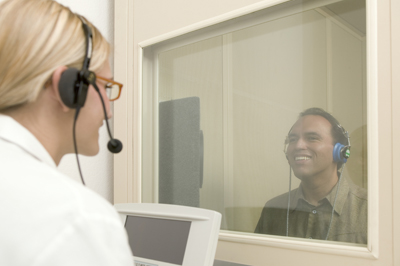Before we can offer you a diagnosis, your hearing will need to be evaluated. Hearing tests are designed not only to reveal if you have a hearing impairment but also its location, severity and frequency.
It’s important to get your hearing tested regularly because early detection is the key to successful treatment.

Hearing experts recommend that anyone over 50 get an annual hearing test. Children who have experienced irregular hearing assessment results and teens or adults who think their hearing may be worsening should also consider regular testing. Hearing assessments are fast, easy, painless and very accurate in diagnosing different types of hearing loss. During testing at our clinic, we may perform a few to several different specific types of hearing tests. Common tests include:
- Air Conduction Hearing Test: This test checks your hearing at varying frequencies by sending varying tones of different pitches through a headset into your ears. It will help your audiologist assess if your hearing loss pertains more to high-pitched sounds, mid-range tones or low-frequency signals. It can also help in determining if your hearing loss is sensorineural (related to the inner ear) or conductive (related to the middle or outer ear). This test is often done in conjunction with a speech audiometry test. Check out our speech audiometry page to learn more.
- Bone Conduction Hearing Test: This test uses the same process as air conduction testing, but tones are sent to a device placed behind your ear instead of through the headphones. This allows sound to bypass your outer and middle ear and pass through your skull to your inner ear. Bone Conduction testing can access your inner ear’s hearing ability without the influence from you outer or middle ear.
- Impedance Audiometry: This test is also known as Tympanometry. It is used to assess the condition of the middle ear and mobility of the eardrum (tympanic membrane) and the conduction bones by creating variations of air pressure in the ear canal. It aids in the assessment of outer ear, middle ear and the Eustachian tube.
- Otoacoustic Emissions (OAE) Hearing Tests: Instead of measuring the response to sound entering the ear, like other tests, the OAE measures the vibrational response (called an otoacoustic emission) coming back out of your ear using a tiny microphone placed near the ear drum. While those with normal hearing will produce detectible emissions, people with impaired hearing will supply minimal or no otoacoustic emissions. This test detects the level of hearing loss and can indicate conductive or sensorineural problems.


